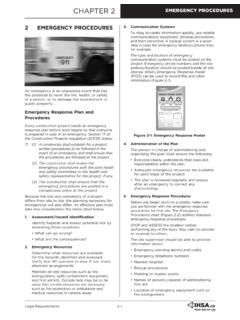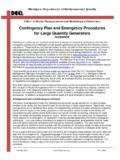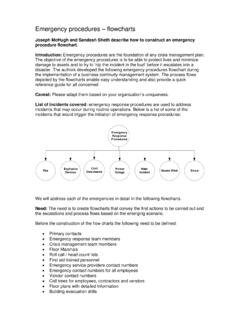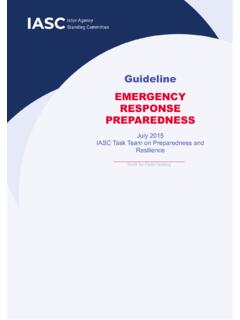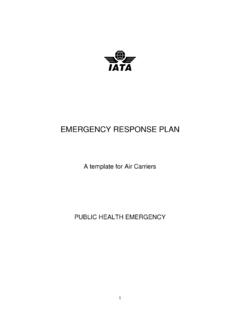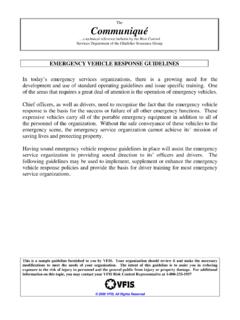Transcription of Hospital emergency response checklist
1 Hospital emergency response checklist An all-hazards tool for Hospital administrators and emergency managers Supported by The European Commission Health Programme 2008-2013. Together for Health Hospital emergency response checklist An all-hazards tool for Hospital administrators and emergency managers Abstract Hospitals play a critical role in providing communities with essential medical care during all types of disaster. De- pending on their scope and nature, disasters can lead to a rapidly increasing service demand that can overwhelm the functional capacity and safety of hospitals and the health-care system at large. The World Health Organization Regional Office for Europe has developed the Hospital emergency response checklist to assist Hospital administrators and emergency managers in responding effectively to the most likely disaster scenarios.
2 This tool comprises current Hospital -based emergency management principles and best practices and integrates priority action required for rapid, effective response to a critical event based on an all-hazards approach. The tool is structured according to nine key components, each with a list of priority action to support Hospital managers and emergency planners in achieving: (1) continuity of essential services; (2) well-coordinated implementation of Hospital operations at every level; (3) clear and accurate internal and external communication; (4) swift adaptation to increased demands; (5) the effective use of scarce resources; and (6) a safe environment for health-care workers. References to selected supplemental tools, guidelines and other applicable resources are provided.
3 The principles and recommendations included in this tool may be used by hospitals at any level of emergency preparedness. The checklist is intended to complement existing multisectoral Hospital emergency management plans and, when possible, augment standard operating procedures during non-crisis situations. This document has been produced with the financial assistance of the European Union. The views expressed herein can in no way be taken to reflect the official opinion of the European Union. Keywords emergency MEDICAL SERVICES. emergency SERVICE, Hospital . DELIVERY OF HEALTH CARE. Hospital PLANNING. Address requests about publications of the WHO Regional Office for Europe to: Publications WHO Regional Office for Europe Scherfigsvej 8.
4 DK-2100 Copenhagen , Denmark Alternatively, complete an online request form for documentation, health information, or for permission to quote or translate, on the Regional Office web site ( ). World Health Organization 2011. All rights reserved. The Regional Office for Europe of the World Health Organization welcomes requests for permission to reproduce or translate its publications, in part or in full. The designations employed and the presentation of the material in this publication do not imply the expression of any opinion whatsoever on the part of the World Health Organization concerning the legal status of any country, territory, city or area or of its authorities, or concerning the delimitation of its frontiers or boundaries.
5 Dotted lines on maps represent approximate border lines for which there may not yet be full agreement. The mention of specific companies or of certain manufacturers' products does not imply that they are endorsed or recommended by the World Health Organization in preference to others of a similar nature that are not mentioned. Errors and omissions excepted, the names of proprietary products are distinguished by initial capital letters. All reasonable precautions have been taken by the World Health Organization to verify the information contained in this publication. However, the pub- lished material is being distributed without warranty of any kind, either express or implied. The responsibility for the interpretation and use of the material lies with the reader.
6 In no event shall the World Health Organization be liable for damages arising from its use. The views expressed by authors, editors, or expert groups do not necessarily represent the decisions or the stated policy of the World Health Organization. Contents Page Main Key component 1. Command and Key component 2. Key component 3. Safety and Key component 4. Key component 5. Surge Key component 6. Continuity of essential Key component 7. Human Key component 8. Logistics and supply Key component 9. Post-disaster Recommended 5. Back Main authors Dr Brian S. Sorensen Attending Physician, Department of emergency Medicine, Brigham and Women's Hospital Associate Faculty, Harvard Humanitarian Initiative Instructor of Medicine, Harvard Medical School Boston United States of America Dr Richard D.
7 Zane Vice Chair, Department of emergency Medicine, Brigham and Women's Hospital Associate Professor of Medicine, Harvard Medical School Boston United States of America Mr Barry E. Wante Director of emergency Management, Center for emergency Preparedness Brigham and Women's Hospital Boston United States of America Dr Mitesh B. Rao emergency Physician, Yale-New Haven Hospital New Haven, Connecticut United States of America Dr Michelangelo Bortolin emergency Physician, Torino emergency Medical Services Adjunct Faculty, Harvard-affiliated Disaster Medicine Fellowship Torino Italy Dr Gerald Rockenschaub Programme Manager, Country emergency Preparedness Programme WHO Regional Office for Europe Copenhagen Denmark 6.
8 Back Glossary Capacity The combination of all the strengths, attributes and resources available within an organization that can be used to achieve agreed goals (1). Command and control The decision-making system responsible for activating, coordinating, implementing, adapting and terminating a pre- established response plan (2). Contingency planning A process that analyses potential events or emerging situations that might threaten society or the environment and establishes arrangements that would enable a timely, effective and appropriate response to such events should they occur. The events may be specific, categorical, or all-hazard. Contingency planning results in organized and coordi- nated courses of action with clearly identified institutional roles and resources, information processes and operational arrangements for specific individuals, groups or departments in times of need (1).
9 Critical event Any event in connection with which a Hospital finds itself unable to deliver care in the customary fashion or to an ac- cepted standard, event resulting in a mismatch of supply (capacity, resources, infrastructure) and demand (patients), and requiring the Hospital to activate contingency measures to meet demand. Disaster Any event or series of events causing a serious disruption of a community's infrastructure often associated with widespread human, material, economic, or environmental loss and impact, the extent of which exceeds the ability of the affected community to mitigate using existing resources (1). emergency A sudden and usually unforeseen event that calls for immediate measures to mitigate impact (3).
10 emergency response plan A set of written procedures that guide emergency actions, facilitate recovery efforts and reduce the impact of an emergency event. Incident action plan A document that guides operational activities of the Incident Command System during the response phase to a particular incident. The document contains the overall incident objectives and strategy, general tactical actions, and supporting information to enable successful completion of objectives (4). Incident command group A multidisciplinary body of the incident command system, which provides the overall technical leadership and over- sight for all aspects of crisis management, coordinates the overall response , approves all action, response and mitiga- tion plans, and serves as an authority on all activities and decisions.










